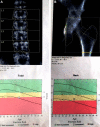Giant mediastinal parathyroid adenoma presenting as bilateral brown tumour of mandible: a rare presentation of primary hyperparathyroidism
- PMID: 29066636
- PMCID: PMC5665274
- DOI: 10.1136/bcr-2017-220722
Giant mediastinal parathyroid adenoma presenting as bilateral brown tumour of mandible: a rare presentation of primary hyperparathyroidism
Abstract
Hyperparathyroidism (HPT) is becoming increasingly common endocrinopathy in clinical practice. Nowadays, it is mostly diagnosed in subclinical or early clinical stage. Bony involvement in HPT has seen significant fall in incidence. Brown tumour of bone is exceptionally rare as a first manifestation of primary HPT (PHPT). Its radiological and histopathological features may be mistaken for other bony pathologies. If possibility of underlying HPT is overlooked the disease is bound to recur after surgery adding to morbidity of the patient. Here we present a case of bilateral brown tumour of mandible which was mistakenly treated as giant cell granuloma by surgical curettage. That the patient was harbouring an ectopic parathyroid adenoma with hypercalcemia causing non-specific symptoms was missed by the referring physician. This led to recurrence of the lesion. On subsequent evaluation, a giant mediastinal parathyroid adenoma causing PHPT was detected at our centre and was removed via mini sternotomy approach.
Keywords: calcium and bone; oral and maxillofacial surgery.
© BMJ Publishing Group Ltd (unless otherwise stated in the text of the article) 2017. All rights reserved. No commercial use is permitted unless otherwise expressly granted.
Conflict of interest statement
Competing interests: None declared.
Figures









References
-
- Kumar S, Bhate K, Pawar V, et al. . Osteitis fibrosa cystica of jaws as diagnostic criteria for hyperparathyroidism–a case report with review of literature. Int J Med Pharm Case Reports 2016;6:1–6. 10.9734/IJMPCR/2016/24344 - DOI
-
- Wanzari PV, Chaudhary A, Reddy V, et al. . Oral manifestations established the diagnosis of hyperparathyroidism: a rare case report. Journal of Indian Academy of Oral Medicine and Radiology 2011;23:155–8. 10.5005/jp-journals-10011-1118 - DOI
-
- Neagoe RM, Sala DT, Borda A, et al. . Clinicopathologic and therapeutic aspects of giant parathyroid adenomas - three case reports and short review of the literature. Rom J Morphol Embryol 2014;55:669–74. - PubMed
Publication types
MeSH terms
Substances
LinkOut - more resources
Full Text Sources
Other Literature Sources
Medical
